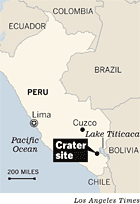
Проанализировав пробы почвы и воды из образовавшегося около деревни Каранкас кратера, специалисты из Перуанского геофизического института (Instituto Geofisico del Peru) пришли к выводу, что кратер возник именно вследствие падения металлического метеорита, сообщает газета Los Angeles Times.
Удар метеорита создал кратер диаметром около двенадцати метров и глубиной чуть менее пяти метров (по другим данным - около двадцати метров в диаметре и восьми метров в глубину) и вызвал сейсмические колебания силой около полутора баллов.
Предполагается, что метеорит в момент удара о Землю был менее метра в диаметре и состоял в основном из металла, заявили эксперты - это противоречит более ранним утверждениям властей, что метеорит был каменным и соответствует мнениям астрономов: каменный метеорит такого размера сгорел бы в атмосфере, не долетев до Земли.
Эксперты опровергли все более ранние версии: вулканическая или гейзерная активность, падение искусственного спутника Земли. Почему население жалуется на недомогание, пока не выяснено. Врачи не исключают вероятность массового психоза: напуганные шумом, которым сопровождалось падение, жители деревни внушили себе, что они отравлены.
Пока не сообщается, что показывают анализы, взятые медиками у пациентов.
Жители Каранкаса, оправившись от испуга, подумывают, не превратить ли кратер в достопримечательность для туристов.
Ссылки по теме
- Meteorite causes a stir in Peru - Los Angeles Times, 21.09.07
Meteorite causes a stir in Peru
"We thought the Chileans were attacking," Junquilla, 53, recalled Thursday, referring to Peru's historical rival, Chile. "That's what everyone was saying. It was very loud."
 Townsfolk in this desolate, high-plains hamlet not far from Lake Tititaca and the Bolivian border received the shock of their lives -- a meteorite that struck nearby with a thunderous bang just before noon Saturday, leaving a deep crater, an acrid smell and terrified villagers and livestock.
Townsfolk in this desolate, high-plains hamlet not far from Lake Tititaca and the Bolivian border received the shock of their lives -- a meteorite that struck nearby with a thunderous bang just before noon Saturday, leaving a deep crater, an acrid smell and terrified villagers and livestock.The meteorite strike cast a spotlight on this hardscrabble outpost of perhaps 3,000 Indian peasants who live in mud-brick homes and make a living by growing potatoes, herding llamas and raising scraggly cattle.
The incident took on a magical realism feel like something out of a Gabriel GarcЁЄa MЁўrquez tale as residents reported strange illnesses and revolting odors, while rumors swirled of a military attack, radiation leak or a celestial rain of gold.
"The day after it fell, we heard this might be worth some money, so we went to pick up everything that was out there," said Eugenio Vilalla, 30. "But there was this terrible smell, really strong, and it gave everyone a headache.
"So the people picked up a few little stones and went home to rest and take a matecito," Villala said, referring to coca-leaf tea, a common cure-all here.
Since then, hundreds have reported maladies, including headaches and nausea. But experts said the reactions probably were imagined. There is no evidence of radiation at the site, officials said.
"Those who say they are affected are the product of a collective psychosis," said Jorge Lopez Tejada, health department chief in Puno, the nearest city.
Authorities took soil and water samples near the crater for analysis.
After days of doubt, they confirmed Thursday that the object was indeed a meteorite -- not volcanic pumice, space junk, or some other Earthly or extraterrestrial phenomenon.
"We're now convinced this was a meteor," said Ronald Woodman, director of the Peruvian Geophysical Institute, which sent a team to the isolated site, about 600 miles southeast of Lima, the capital. "This kind of phenomenon can be dangerous, if it falls on a town, or on a house or person. Fortunately, this wasn't the case."
The object, metallic in nature, created a crater 41 feet in diameter and produced a seismic shock equivalent to a 1.5-magnitude earthquake, Woodman said.
Authorities say the crater was about 16 feet deep.
Experts from Peru's nuclear energy institute estimated that the meteorite was no more than 3 feet in diameter when it smashed into Earth at an extremely high speed.
That piece may have been all that remained of a much larger object that burned up while streaking through Earth's atmosphere, experts said.
The event has drawn worldwide interest, since few objects from outer space make it all the way to Earth's surface.
And it has caused a sensation in this drowsy corner of the Andean altiplano.
"Even before it fell, there was a strong sound, like an airplane," said Marina Llanqui Mamani, 53. "And when it hit, it felt like an earthquake. Everyone was terrified. Even my animals were running all around in fear. Then there was a loud noise and a lot of smoke."
The pungent odor, experts say, could have been caused when the crashing object fused with such elements as sulfur in the soil.
With the danger seemingly past, some here are thinking big: Why not make the whole deal a tourist site, a small museum and side trip for the many visitors headed to Lake Titicaca and Bolivia?
"Now that various experts from Japan and other countries have assured us there is nothing bad, we have decided this belongs to us," said Benito Mosaja Pari, 56, who called himself the village lieutenant governor.
"We're going to dig it out. The scientists tell us this was part of a world that fell apart. It has some value.
"And now it's ours."
patrick.mcdonnell@latimes.com
Special correspondent Fernandez reported from Carancas and Times staff writer McDonnell from Buenos Aires. Special correspondent Adriana Leon in Lima contributed to this report.
